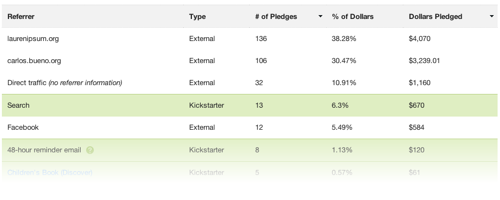Rocking Kickstarter
This is just a list of things I learned from one failed and one successful Kickstarter project. Everyone is different but I hope this will be useful to you. I will assume that you are producing an object with simple manufacturing: a book, a game, a toy, etc.

A story about computer science
and other improbable things.
“I once made the mistake of generalizing from a single data point. I'll never do that again!”
– Achilles the Logician
Do something very specific with the money.
We raised money to pay for translations of our book. We didn't need money for the English edition. Between my wife and I we had the technical, graphic, and writing skills to produce a book. While it was sometimes hard to work nights & weekends, it was doable.
But we believe that internationalization is as important for books as it is for software. A good translation requires serious amounts of specialized work, so that's what we asked backers to help pay for.
Keep the rewards simple to understand.
Fine-grained price discrimination is a big-league tool. You are not big-league. I suspect that too many different reward tiers causes potential backers to be overwhelmed by choice. With Lauren Ipsum we offered digital copies, signed paper copies and prints of the illustrations. $5 extra for international postage. That was it. Fulfillment was still an undertaking, but more manageable because of the simplicity.
Charge a lot.
Make sure there is a decent profit on every reward tier. Remember taxes, transaction fees, and shipping. My rule of thumb was to charge double the intended retail price for each item. Selling a hardcover for $60 might feel weird at first, but it's perfectly fine. You'll see less of that than you think. :)
The mix of backers for Ipsum was interesting: about 40% bought digital versions, 35% paperback, and the rest hardcovers and prints. The average revenue per backer was $32, and the average fulfillment cost was about $12. Even without the pure-margin digital tier and high-margin print tier we would have made a good sum. This is key.
Avoid timesinks.
Sure, it's fun and whimsical to offer hand-painted t-shirts or home-baked cookies as a reward, but how many of those can you do? The point of Kickstarter is to trade money for time in the other direction. Backers give you money which you give to other people (eg, your landlord), in exchange for time to produce your actual project. Offering labor-intensive rewards that do not move your project forward are a net loss. A good bad example would be “$5 gets you a sticker of your choice”. At first this sounds reasonable. You want to offer something for a small token payment. But even leaving aside the shipping costs, having to match the backer's choice with the sticker with the envelope will eat up all your time.
Exclusive access is the most precious reward.
Consider offering backers exclusive access to whatever you're producing for a month. This is a unique selling point that scales, and costs you absolutely nothing. It's also a good way to get that crucial pre-launch feedback. Think of it as the dress rehearsal.
Ask backers to help you bridge the gap.
The gap between attracting backers and hawking your wares in the general marketplace is huge. You lose almost all of the social credit you built up inside the Kickstarter nest. No one knows you on Amazon, and no one cares how many people liked you on some other site. This is bad, but manageable.

Once you're mailed out the last package, schedule a period of rest before the real work of launching begins. This is where leaving a few weeks of “beta” time between the end of the Kickstarter and your official launch helps. This gives backers time to receive the work, give you feedback, brag about it online, and so on.
Then you open the curtains and put your work on general sale. Send an update to your backers, asking them to rate and review on various sites. They want to help you. They just got their reward and they will welcome the chance to help your project some more.
Kickstarter gives you awesome analytics.

Believe me, you'll miss it later. The most interesting fact was the hit-based nature of backing. There were some sales from people browsing the site itself, but over 90% came from external clicks directly to the project page. If I was able to get an interesting article out in front of a few thousand people, there would be a burst of purchases that decayed in 2-3 days. Ipsum never reached a self-sustaining critical mass to shoot it to $100K or $1M, but we ended up with a respectable $10K.
This data informed the marketing plan post-Kickstarter. None of the marketing plays we tried worked except press hits, and the timing of those hits is as important as their magnitude.